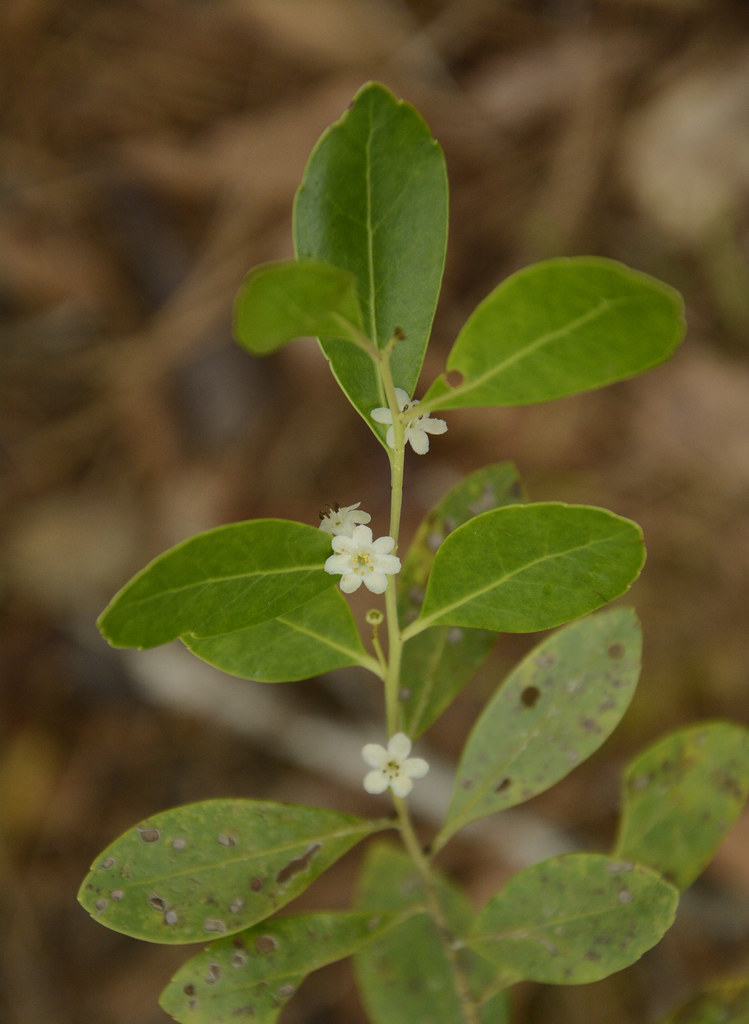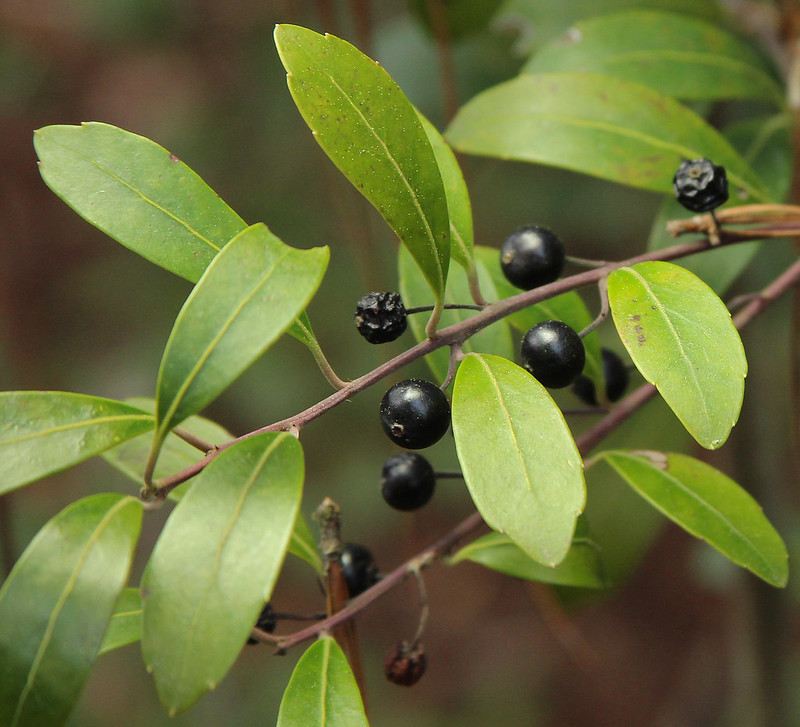Native Plant Profile: Inkberry (Ilex glabra)
Inkberry (Ilex glabra) is one of our native, compact shrubs in the holly family (Aquifoliaceae) that keeps its leaves year-round. It is a relatively slow growing species that maxes out at heights of 5- 8 feet tall. It sometimes will form clumps with numerous sprouts, making it a great plant to use as a low hedge or border. The leaves are evergreen, finely toothed and can get up to 2.5 inches long. They appear dark green and shiny above with a lighter, duller appearance below.
Inkberry, like other hollies, has both male and female plants which produce slightly different flowers. Both sexes have greenish-white flowers in May and June that sometimes are inconspicuous. If pollinated, female flowers will produce nearly black, shiny fruits in September-October. The fruits often persist on the plant through much of the winter, requiring several freezes and thaws before the starches become palatable to local birds. Be sure to plant both male and female inkberry in your yard if your goal is to have fruits.
Inkberry is versatile and can grow in full sun to full shade. It prefers moist, well-drained and acidic soil. However, it can tolerate occasional flooding, clay soil, and even road salt run-off.
Because of its tendency to form colonies, inkberry sometimes requires the removal of suckers to keep the plant in place. Cultivars like Ilex glabra ‘Compacta’ and Ilex glabra ‘Chamzin’ tend to be more compact than the straight species. The latter cultivar typically only grows 3-4 feet high, making it ideal for smaller yards.
While inkberry has low nutritional value for most native wildlife, it does provide important winter cover for wildlife. In addition, birds like American Robins will consume the fruits when ripe in late winter. Henry’s Elfin butterfly hosts on this plant, and smaller pollinators enjoy the nectar and pollen. Inkberry is also known as gallberry, and the honey produced by honeybees from this plant is said to be highly rated for its unique flavor. Native Americans sometimes would brew a black tea from its leaves.
References:
Missouri Botanical Garden. Ilex glabra. http://www.missouribotanicalgarden.org/PlantFinder/PlantFinderDetails.aspx?kempercode=d553 Accessed January 10, 2020.
USDA, NRCS. 2020. The PLANTS Database (http://plants.usda.gov). National Plant Data Team, Greensboro, NC 27401-4901 USA. Accessed January 13, 2020.
Happy New Year HabiChat fans!
Winter can be a tough time of year for many of our local wildlife species. You can give them a hand by creating habitat and providing natural foods. In this winter edition of HabiChat, learn about Cedar Waxwings, a lovely resident bird that can be found in backyards, as well as our native inkberry holly that provides important cover. In addition, this issue also includes articles on Winter Greens for Wildlife, Eastern Screech Owl Nest Boxes, and how to help with the 3rd Maryland-DC Breeding Bird Atlas.
Winter is also a time for maintenance projects, so don’t forget to clean out and repair nest boxes and prune your shrubs and trees. If you are feeding birds, please also make sure to keep those feeders clean. In addition, water is crucial to many species this time of year. Consider adding a heated bird bath or pet water bowl to your landscape to help local wildlife. If you are looking for fun projects to do with the kids, why not go on a winter safari or make seed wreaths for the birds?
Finally, I am pleased to announce that we have completed the Simple School Wildlife Garden Guide. The guide contains basic information on how to start a school wildlife garden and includes suggested plants and designs for three types of gardens: a monarch garden, a songbird garden, and a pollinator garden. The guide can be found on our Schoolyard Wildlife Habitat page.
Happy Habitats,
Kerry Wixted
Click here to have HabiChat—the quarterly backyard wildlife habitat newsletter from the Wild Acres program—delivered right to your inbox!
In this Issue
Breeding Bird Atlas
Habitat Tip: Eastern Screech Owl Nest Boxes
Habitat Tip: Winter Greens for Wildlife
Native Animal Profile: Cedar Waxwing




 1-888-373-7888
1-888-373-7888 233733
233733